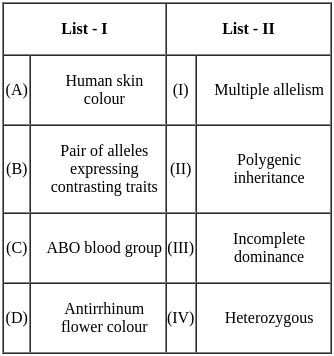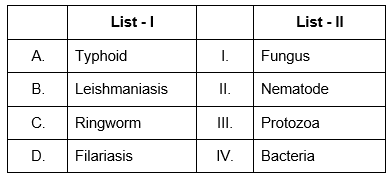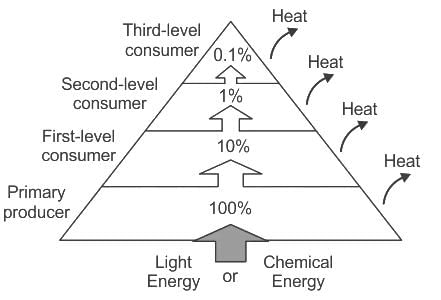Biology: CUET Mock Test - 3 - CUET MCQ
30 Questions MCQ Test - Biology: CUET Mock Test - 3
Match List - I with List - II.

Choose the correct answer from the options given below:

Identify the regions of the transcription unit.
(A) Promoter
(B) Sigma factor
(C) Terminator
(D) The structural gene
Choose the correct answer from the options given below:
Which of the following product is produced by Monascus purpureus?
Which of the following statements are correct?
(A) Sex education is necessary in schools to improve reproductive health awareness.
(B) Family planning programs aim to control population growth.
(C) Male contraceptive options are as abundant as female contraceptive options.
(D) Surgical methods of contraception are reversible and highly effective.
(E) MTP is legal in India but with strict conditions.
Choose the correct answer from the options given below:
Which of the following statements are correct?
(A) A Punnett square helps predict the possible genotypes of offspring.
(B) The genotype of an organism can always be determined by its phenotype.
(C) Mendel’s Law of Segregation explains the independent assortment of alleles.
(D) In co-dominance, both alleles contribute equally to the phenotype.
(E) The Law of Dominance is applicable only when alleles are identical.
Choose the correct answer from the options given below:
Which of the following statements are correct?
(A) The presence of two X chromosomes in humans results in a female genotype.
(B) In the XY system of sex determination, the Y chromosome determines male traits.
(C) Down's syndrome is caused by the presence of an extra chromosome 21.
(D) Haemophilia is a sex-linked recessive disorder transmitted through the Y chromosome.
(E) Klinefelter’s syndrome is characterized by the absence of an X chromosome.
Choose the correct answer from the options given below:
What happens after the pollen grain germinates on the stigma?
Where do the sperm cells travel after the pollen grain germinates?
Choose the correct answer among the alternatives given :
Which of the following contraceptive methods correctly matches with its mode of action?
The difference between Homo sapiens and the Homo erectus was ____.
Read the following statements and select the correct option.
Statement 1: Malarial parasite requires two hosts - humans and mosquitoes to complete its life cycle.
Statement 2: Haemozoin is a toxic substance produced by the rupturing of liver cells during malarial infection.
The inflammatory response in allergy is due to the release of ________ by mast cells.
Match List I with List II: (NEET 2024)

Choose the correct answer from the options given below:
Biogas generation is a three-stage anaerobic digestion of animal and other organic wastes. Study the following flow chart and select the correct option for stages I, II and Ill.
A microbial biocontrol agent that can be used to control butterfly caterpillars is:
The enzyme (a) is needed for isolating genetic material from plant cells and enzyme (b) for isolating genetic material from fungus. Choose the correct pair of options from the following :
Given below are two statements : one is labelled as Assertion (A) and the other is labelled as Reason (R).
Assertion (A) : Polymerase chain reaction is used in DNA amplification.
Reason (R) : The ampicillin resistant gene is used as a selectable marker to check transformation.
In the light of the above statements, choose the correct answer from the options given below :
'Golden rice' developed through transgene approach is enriched with
Given figure represents the maturation of pro-insulin into insulin. Identify the product A.

Which of the following equations correctly represents verhulst-Pearl logistic growth?
Small fish get stuck near the bottom of a shark and derive their nutrition from it? This kind of association is called
Identify the correct statements: (NEET 2023)
A. Detrivores perform fragmentation.
B. The humus is further degraded by some microbes during mineralization.
C. Water soluble inorganic nutrients go down into the soil and get precipitated by a process called leaching.
D. The detritus food chain begins with living organisms.
E. Earthworms break down detritus into smaller particles by a process called catabolism.
Choose the correct answer from the options given below:
In the equation GPP − R= NPP (NEET 2023)
GPP is Gross Primary Productivity
NPP is Net Primary Productivity
R here is ________.


















